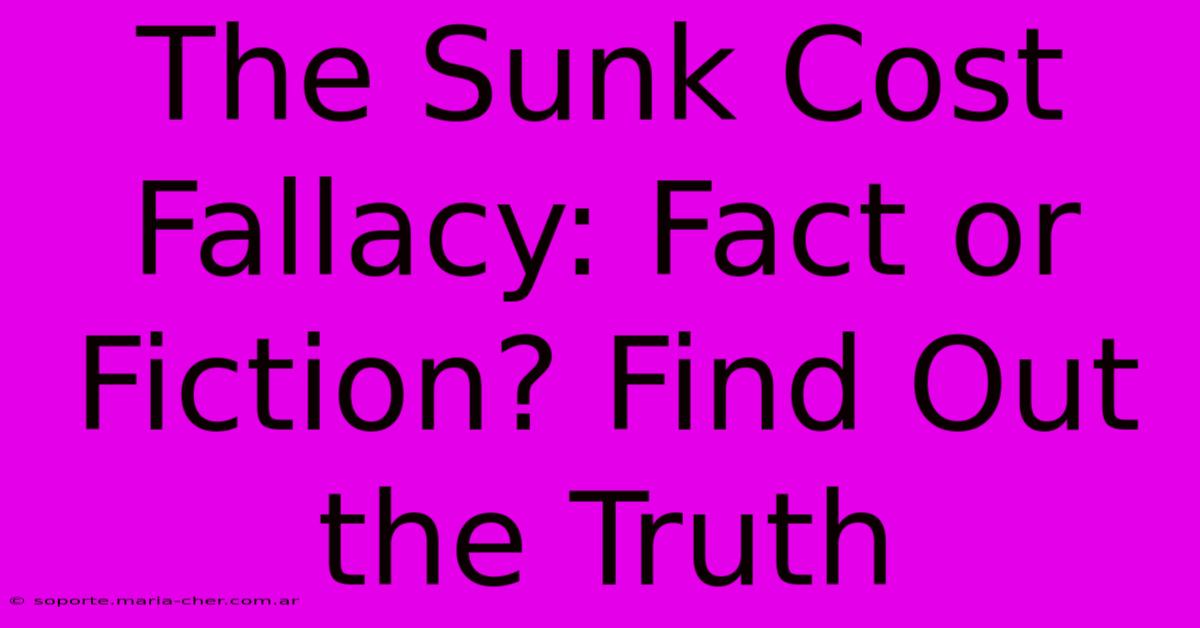The Sunk Cost Fallacy: Fact Or Fiction? Find Out The Truth

Table of Contents
The Sunk Cost Fallacy: Fact or Fiction? Find Out the Truth
We've all been there. You've invested time, money, or effort into something – a project at work, a relationship, even a terrible movie – and despite clear signs it's going nowhere, you persist. Why? Because you've already invested so much. This is the sunk cost fallacy, and it's a powerful cognitive bias that affects decisions across all aspects of life. But is it just a quirky quirk of human psychology, or is there a deeper truth to this seemingly illogical behavior? Let's delve into the facts and find out.
Understanding the Sunk Cost Fallacy
The sunk cost fallacy is the tendency to continue investing in something – be it time, money, or effort – simply because you've already invested resources in it, even when it's clearly not worth the continued investment. Sunk costs are unrecoverable past expenses. The crucial point is that these costs are irrelevant to future decisions. Rationally, you should base your future actions only on the expected future costs and benefits, not on what you've already spent.
Examples of the Sunk Cost Fallacy in Action:
- Finishing a bad movie: You paid for the ticket, so you sit through a terrible film, even though you're bored and wishing you were doing something else.
- Staying in a failing business: You've poured years and significant capital into a struggling business. Despite mounting losses, you continue investing, hoping to recoup your initial investment, even though the chances of success are slim.
- Persisting in a toxic relationship: You’ve invested years and emotions into a relationship that's clearly unhealthy. Despite unhappiness, you stay because you don't want to "waste" all the time you've already spent.
- Completing a degree you hate: You're almost finished with a degree program you no longer enjoy or believe will benefit you. Instead of switching majors or dropping out, you push through, clinging to the idea of not "wasting" what you've already done.
Why Do We Fall Prey to the Sunk Cost Fallacy?
The sunk cost fallacy isn't simply irrationality; it's a complex psychological phenomenon with several contributing factors:
- Loss aversion: We feel the pain of a loss more strongly than the pleasure of an equivalent gain. Cutting our losses feels worse than accepting a smaller loss and moving on.
- Cognitive dissonance: Continuing to invest justifies our past decisions. Admitting we made a mistake and stopping feels like a failure.
- Confirmation bias: We tend to seek out information that confirms our existing beliefs. If we've already invested heavily, we might focus on evidence that suggests the investment will eventually pay off, ignoring contrary evidence.
- Social pressure and commitment: We might persist because we've publicly committed to a course of action, and abandoning it would feel embarrassing or make us look bad to others.
Overcoming the Sunk Cost Fallacy: Making Rational Decisions
Recognizing the sunk cost fallacy is the first step toward overcoming it. Here's how to break free:
- Focus on the future: Detach yourself emotionally from past investments. Ask yourself: "If I were starting this project/relationship/etc. today, knowing what I know now, would I still invest in it?"
- Embrace losses: Accept that sometimes you make mistakes. It's okay to cut your losses and move on.
- Seek objective perspectives: Talk to trusted friends, family, or mentors who can offer an unbiased assessment.
- Track your progress: Objectively assess whether your investment is yielding the expected results.
- Set clear exit strategies: Determine beforehand what conditions would trigger you to stop investing.
The Sunk Cost Fallacy: A Truth We Must Confront
The sunk cost fallacy is a very real and pervasive cognitive bias. While it's rooted in our psychology, understanding its mechanisms empowers us to make more rational decisions. By consciously recognizing and addressing this bias, we can avoid wasting valuable resources and make choices that truly align with our future goals and well-being. It's not about ignoring the past, but about learning from it and making smarter choices for the future. The truth is, clinging to sunk costs prevents us from achieving greater success. Let go, and move on.

Thank you for visiting our website wich cover about The Sunk Cost Fallacy: Fact Or Fiction? Find Out The Truth. We hope the information provided has been useful to you. Feel free to contact us if you have any questions or need further assistance. See you next time and dont miss to bookmark.
Featured Posts
-
Horns Pointing High Understanding The Upside Down Bulls Logo Phenomenon
Feb 04, 2025
-
Prepare To Be Amazed The Incredible Transformation Of Oil Can Fresno
Feb 04, 2025
-
Elevate Your Chemistry Degree To New Heights Explore Our World Leading Recruitment Brochure
Feb 04, 2025
-
Effortless Passive To Active Conversion Unlock Your Writings Potential
Feb 04, 2025
-
Unlock The Forbidden The Ultimate List Of Shortable Restricted Stocks
Feb 04, 2025
